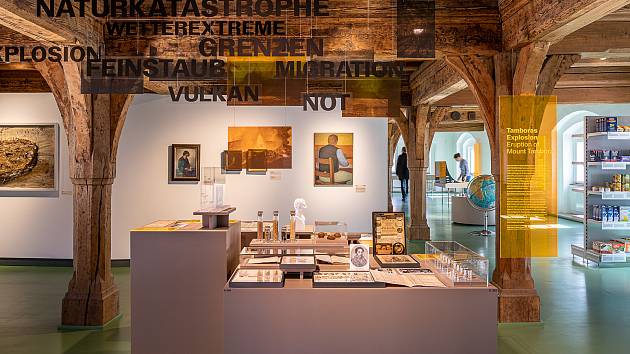It contains a collection of more than two hundred penises belonging to almost every land and sea mammal that can be found in Iceland. The remaining specimens are imported from abroad. In addition, visitors can see a collection of approximately 350 art creations and practical objects related to this theme.
There are places in the world that are scorching hot. Yet people live there
The museum’s history dates back to 1974, when its founder Sigurður Hjartarson received a whip woven from a bull’s leg. He then worked as a high school principal in the city of Akranes on the southwest coast. “Some of my teachers worked at a nearby whaling station during the summer and after the first specimen they started bringing me whale penis, supposedly to tempt me. Then gradually the idea emerged that it might be interesting to collect specimens from several species of mammals,” Sigurður Hjartarson said on the museum’s website.
The collection is gradually increasing. When Sigurður Hjartarson collected 62 genitals in 1997, he started exhibiting them in museums.
Bad art life
Art is so bad that it cannot be ignored. The Museum of Bad Art (MOBA) in Massachusetts lives up to this slogan. On its website, the museum describes itself as a community-based non-profit dedicated to collecting, preserving, exhibiting and celebrating ugly art in all its forms and glory.
According to Amusing Planet North, it all started one night when the museum’s founder, antiques dealer Scott Wilson, removed a painting entitled Lucy in the Field with Flowers from a trash can. It was such an ugly piece that he didn’t throw it away, but instead showed it to his friends. They were so excited that they suggested he start a collection of equally horrific items. Wilson gradually acquired some shoddy pieces and began hosting receptions at friends’ homes.
Best water parks in Croatia: See what fun they have to offer
The MOBA was founded in the fall of 1993 and was first made available to the public the spring of the following year. The response was overwhelming, and since then the museum’s collection and ambitions have grown successfully. Since its founding, the museum has moved several times. It’s been closed indefinitely since earlier this year, but before it reopens, fans of really bad art can feast their eyes on Facebook and the museum’s website.
Bread as an exhibit
Bread. Few people stop to think about one of the most common foods. At the same time, even in the well-known Christian prayer, the verse “Give us this day our daily bread” indicates that even the most ordinary food is something that we should cherish. And not only that. The Museum of Bread and Art (Museum Brot und Kunst) in the German city of Ulm will convince you that bread is irresistible.
This exhibition is divided into two parts. The first is an art collection with works from the 15th to 21st centuries. There you will find gems such as paintings by Rembrandt, Chagall, Pechstein, Picasso and many other world-renowned artists. In the second part of the exhibition, the social, cultural and technical contexts around agriculture, food and bread are presented in the form of nineteen themes. As stated on the Deutsches Brotinstitut website, both sections emphasize interpretation and understanding of the world around us.
Unusual experience right across the border. Dragon Lake is home to a number of bird species
The fact that Germany is the right place for such an exhibition is also evidenced by the fact that in 2014, the German bread culture with its 3,200 registered varieties was included in the UNESCO national list of intangible cultural heritage. The German Bread List is the first archive of its kind. Artisan bakers who are part of a guild can register their delicious creations online.
Failed love
The collections at the Museum of Broken Relationships tell stories about how we love and how we lose. Located in the beautiful Baroque Kulmer Palace in Zagreb, it even boasts the Kenneth Hudson EMYA Award for Europe’s most innovative and daring museum project, which it won in 2010.
At its heart, the museum is a growing collection of objects, each of which tells a story of a love gone wrong. The exhibits on display are accompanied by anonymous stories from contributors.
QUIZ: Halászlé and Balaton. How well do you know Hungary?
For example, if you yourself are going through a painful breakup and wondering how to handle things that remind you of your ex, you might contribute another item to the collection. It is enough to fill out a simple form on the museum website brokenships.com and send the given object to the main museum in Zagreb or to its branches in France and Mexico. You can also find what’s called a global map of broken hearts on the website. This is actually a collection of breakup stories based on locations shared by people from all over the world.
The Museum of Broken Relationships is a fascinating investigation into human emotions and forms of therapy. According to its founders, Olinka Vištica and Dražen Grubišić, visitors and contributors offer an opportunity to recover from failed relationships through humor and empathy. Many people then consider this place as a kind of ritual space, where they can also leave their past by throwing away certain objects.
Its main role is salt and pepper
An extraordinary 20,000 pairs of salt and pepper shakers can be found at The Salt and Pepper Shaker Museum in Gatlinburg, Tennessee. And that’s not all! Another 20,000 are in a newer museum on Guadalest in eastern Spain. Owners and curators Andrea and Rolf Ludden began collecting more than 35 years ago.
As they write on the museum’s website, it all started innocently, when the couple discovered they didn’t have any pepper grinders at home. They go shopping and discover that there is an almost infinite number of shapes, patterns, and colors of salt and pepper shakers. Collecting gradually became a family hobby, in which son Alex and daughter Andrey also joined. At the turn of the millennium, when her collection had filled most of their home and tensions between the couple had soared to the point of even hearing the word “divorce”, they decided to open a museum. In 2001, they moved from Texas to the Smoky Mountains to create the world’s only museum.
According to the owner, the main purpose of this museum is to show changes in society through salt and pepper shakers. This fascinating collection contains truly unique pieces made from the 1500s to the present day.

“Unapologetic social media guru. General reader. Incurable pop culture specialist.”










